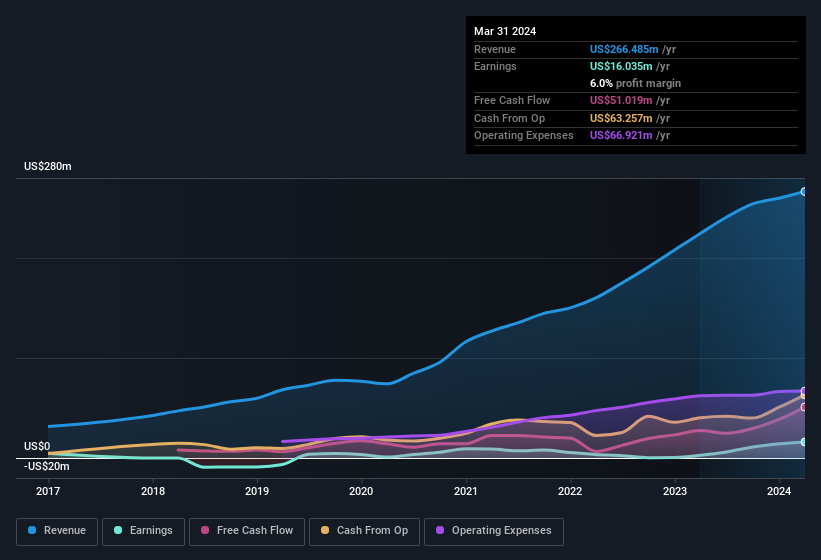- United States
- /
- Insurance
- /
- NasdaqGS:GSHD
If EPS Growth Is Important To You, Goosehead Insurance (NASDAQ:GSHD) Presents An Opportunity

The excitement of investing in a company that can reverse its fortunes is a big draw for some speculators, so even companies that have no revenue, no profit, and a record of falling short, can manage to find investors. But as Peter Lynch said in One Up On Wall Street, 'Long shots almost never pay off.' Loss making companies can act like a sponge for capital - so investors should be cautious that they're not throwing good money after bad.
Despite being in the age of tech-stock blue-sky investing, many investors still adopt a more traditional strategy; buying shares in profitable companies like Goosehead Insurance (NASDAQ:GSHD). Even if this company is fairly valued by the market, investors would agree that generating consistent profits will continue to provide Goosehead Insurance with the means to add long-term value to shareholders.
See our latest analysis for Goosehead Insurance
Goosehead Insurance's Earnings Per Share Are Growing
The market is a voting machine in the short term, but a weighing machine in the long term, so you'd expect share price to follow earnings per share (EPS) outcomes eventually. Therefore, there are plenty of investors who like to buy shares in companies that are growing EPS. Goosehead Insurance managed to grow EPS by 7.1% per year, over three years. While that sort of growth rate isn't anything to write home about, it does show the business is growing.
Top-line growth is a great indicator that growth is sustainable, and combined with a high earnings before interest and taxation (EBIT) margin, it's a great way for a company to maintain a competitive advantage in the market. The music to the ears of Goosehead Insurance shareholders is that EBIT margins have grown from 7.2% to 12% in the last 12 months and revenues are on an upwards trend as well. That's great to see, on both counts.
The chart below shows how the company's bottom and top lines have progressed over time. For finer detail, click on the image.

Of course the knack is to find stocks that have their best days in the future, not in the past. You could base your opinion on past performance, of course, but you may also want to check this interactive graph of professional analyst EPS forecasts for Goosehead Insurance.
Are Goosehead Insurance Insiders Aligned With All Shareholders?
Investors are always searching for a vote of confidence in the companies they hold and insider buying is one of the key indicators for optimism on the market. This view is based on the possibility that stock purchases signal bullishness on behalf of the buyer. However, small purchases are not always indicative of conviction, and insiders don't always get it right.
It's pleasing to note that insiders spent US$1.5m buying Goosehead Insurance shares, over the last year, without reporting any share sales whatsoever. The shareholders within the general public should find themselves expectant and certainly hopeful, that this large outlay signals prescient optimism for the business. It is also worth noting that it was President Mark Miller who made the biggest single purchase, worth US$581k, paying US$58.14 per share.
The good news, alongside the insider buying, for Goosehead Insurance bulls is that insiders (collectively) have a meaningful investment in the stock. Holding US$57m worth of stock in the company is no laughing matter and insiders will be committed in delivering the best outcomes for shareholders. That's certainly enough to let shareholders know that management will be very focussed on long term growth.
While insiders are apparently happy to hold and accumulate shares, that is just part of the big picture. That's because on our analysis the CEO, Mark Miller, is paid less than the median for similar sized companies. Our analysis has discovered that the median total compensation for the CEOs of companies like Goosehead Insurance with market caps between US$2.0b and US$6.4b is about US$6.7m.
The CEO of Goosehead Insurance only received US$1.9m in total compensation for the year ending December 2023. That looks like a modest pay packet, and may hint at a certain respect for the interests of shareholders. CEO compensation is hardly the most important aspect of a company to consider, but when it's reasonable, that gives a little more confidence that leadership are looking out for shareholder interests. It can also be a sign of good governance, more generally.
Should You Add Goosehead Insurance To Your Watchlist?
As previously touched on, Goosehead Insurance is a growing business, which is encouraging. On top of that, we've seen insiders buying shares even though they already own plenty. These factors alone make the company an interesting prospect for your watchlist, as well as continuing research. We should say that we've discovered 1 warning sign for Goosehead Insurance that you should be aware of before investing here.
There are plenty of other companies that have insiders buying up shares. So if you like the sound of Goosehead Insurance, you'll probably love this curated collection of companies in the US that have an attractive valuation alongside insider buying in the last three months.
Please note the insider transactions discussed in this article refer to reportable transactions in the relevant jurisdiction.
If you're looking to trade Goosehead Insurance, open an account with the lowest-cost platform trusted by professionals, Interactive Brokers.
With clients in over 200 countries and territories, and access to 160 markets, IBKR lets you trade stocks, options, futures, forex, bonds and funds from a single integrated account.
Enjoy no hidden fees, no account minimums, and FX conversion rates as low as 0.03%, far better than what most brokers offer.
Sponsored ContentNew: Manage All Your Stock Portfolios in One Place
We've created the ultimate portfolio companion for stock investors, and it's free.
• Connect an unlimited number of Portfolios and see your total in one currency
• Be alerted to new Warning Signs or Risks via email or mobile
• Track the Fair Value of your stocks
Have feedback on this article? Concerned about the content? Get in touch with us directly. Alternatively, email editorial-team (at) simplywallst.com.
This article by Simply Wall St is general in nature. We provide commentary based on historical data and analyst forecasts only using an unbiased methodology and our articles are not intended to be financial advice. It does not constitute a recommendation to buy or sell any stock, and does not take account of your objectives, or your financial situation. We aim to bring you long-term focused analysis driven by fundamental data. Note that our analysis may not factor in the latest price-sensitive company announcements or qualitative material. Simply Wall St has no position in any stocks mentioned.
Have feedback on this article? Concerned about the content? Get in touch with us directly. Alternatively, email editorial-team@simplywallst.com
About NasdaqGS:GSHD
Goosehead Insurance
Operates as a holding company for Goosehead Financial, LLC that engages in the provision of personal lines insurance agency services in the United States.
High growth potential with solid track record.
Similar Companies
Market Insights
Community Narratives



